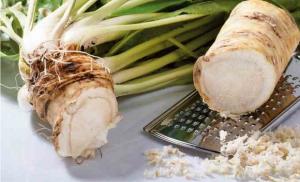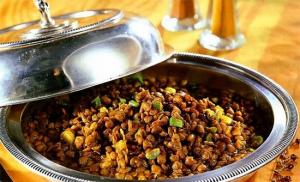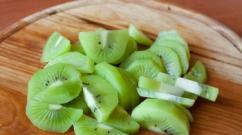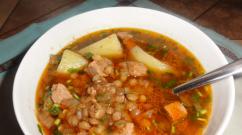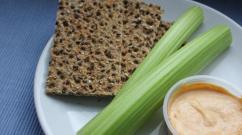Winter preparations from horseradish with lemon. Preparing horseradish for the winter
It is simply impossible to convey the flavor of Russian cuisine without a seasoning such as horseradish. From time immemorial, our ancestors prepared the burning root, using it in cooking and treating ailments. Preparing horseradish for the winter at home is a troublesome process, but the aroma of the product alone is worth it! But the hot spice contains vitamins, minerals, essential oils, and phytoncides that help strengthen the immune system. Therefore, you should definitely stock up on this fragrant assistant. Methods for storing horseradish are described in detail below.
Horseradish is a typical perennial that is propagated by root cuttings. The vitality of this plant is amazing - adult specimens develop even from tiny pieces of root and are not afraid of severe frosts. There are also cultural forms that are especially common in Europe.
Do you know that…
Gardeners note the rapid growth of adult individuals, so they try to fence off the growing area using plastic or slate dug around the perimeter of the bed.
To prepare horseradish for the winter, roots that are 2-3 years old are used. The young shoots do not have as pronounced characteristic taste qualities, and the old rhizomes are too coarse.
They are dug up in the fall, before the first frost, focusing on the climatic conditions of their region. If you miss the required deadline, the roots will become brittle, which will affect their safety.
It is permissible to harvest in the spring, but this must be done before the flower stalks are laid. Otherwise, the plant will begin to use reserves to form seeds, which will affect the nutritional and beneficial qualities.
Algorithm for harvesting and preparing for storage:
- Remove foliage and set aside for processing.
- Using a shovel or pitchfork, dig around the bush at some distance.
- Carefully remove the roots and clean off the soil, being careful not to damage the skin.
- Place the dug roots to dry in a dry, warm room with good ventilation.
- Carry out culling by selecting for storage horseradish with a diameter of over 10 mm. Make sure there is no damage or rotting areas, and cut off any remaining tops.

A high-quality product has a white cut and a juicy, meaty structure.
When purchasing on the market, follow the rules described above. Set aside damaged root vegetables that are unsuitable for long-term storage for processing.
Storage methods
How to store horseradish root? Each housewife can choose a convenient method that will ensure the shelf life of a useful product:
- bookmark in the cellar, basement;
- cold storage;
- freezing;
- drying;
- preservation, preparation of sauces, snacks.
Let's look at each of them in more detail.
How to store in a cellar, basement
The best way to preserve the freshness, benefits and pungency of aromatic roots is to store them in a cellar or basement. The storage should be pre-prepared by disinfecting the shelves and walls with a solution of bleach, copper sulfate or sulfur bomb.
Optimal storage conditions in the cellar:
- humidity 85-90%;
- good ventilation;
- temperature background 0-2 °C.
Wooden boxes and clean, damp sand, perlite or vermiculite are suitable for storing horseradish in the cellar (see):
- Place a layer of filler at the bottom of the container.
- Form the next layer from selected unwashed roots, which need to be laid out at some distance from each other.
- Fill the box in layers so that the filler is on top.
The roots will remain fresh for 10-12 months, just periodically inspect them to remove spoiled specimens and moisten the substrate with a spray bottle once a week.
If a box is not found, you can similarly form a pyramid directly on the floor of the cellar. Also, an alternative to boxes is a bucket filled with garden soil. The soil should be slightly moistened and the roots should be buried at a distance from each other. The storage technology is identical.
Tip of the day
Place the fragrant roots in one box with. Phytoncides will protect carrots from spoilage.
How to keep vegetables fresh in an apartment
How to store horseradish at home if you don’t have a cellar:
- If there is a balcony, the technology of laying in sand is used on the balcony.
- To prevent severe frost from spoiling the harvest, cover the container with roots with a blanket or felt.

To preserve the pungency and aroma of horseradish, it is better to store it fresh and process it as needed.
Storing whole roots in the vegetable compartment of the refrigerator
If you don’t have an equipped storage facility, you can put the horseradish in the refrigerator. The temperature and humidity conditions in the vegetable compartment are suitable for storing small crops.
How to store horseradish in the refrigerator? There are two ways:
- Wash the roots thoroughly and dry on a paper towel. After drying, place the roots in a plastic bag and seal tightly. You can use an airtight food container. The freshness of the crop will remain for 8-10 weeks.
- Wrap the unwashed roots, cleared of soil, one at a time, in cling film. Make several ventilation holes, put it on the vegetable shelf. The shelf life will be about 5 months.
When removing seasonings for cooking, inspect them for spoilage. Towards the end of the shelf life, use the spice for preparations.
Do you know that…
When rubbing horseradish, the space is disinfected. Horseradish phytoncides, scattering throughout the room, kill malicious pathogenic microflora, so it is better to prepare an aromatic seasoning during the approaching epidemics of acute respiratory infections.
Freezing horseradish roots
Housewives are wondering whether it is possible to freeze horseradish root. Certainly! This method is practical and allows you to preserve the beneficial properties, aroma and taste of the product for a period of 10-18 months.
Freezing Tips:
- Before storing, horseradish roots should be soaked overnight in cold water, and then thoroughly washed, dried and peeled.
- You can put whole or chopped roots into the freezer compartment, or chopped in a meat grinder or grater. Whole or chopped horseradish is suitable for canning, and grated horseradish is ideal as an additive to marinades and sauces.
- When using electric shredders, the power of the device should not be less than 700 W. A low-power device is unlikely to cope with tough rhizomes.
- Pieces and whole roots are pre-frozen on a baking sheet and then transferred to individual ziplock bags or plastic containers.
- You can freeze horseradish for the winter in the form of cubes. To do this, grind the root vegetable on a grater or twist in a meat grinder. Place the dough in molds and freeze. Once frozen, remove the cubes and transfer to an airtight container.
- Pack frozen semi-finished products in small portions, ensuring the integrity of the packaging.
You can immediately add your favorite ingredients to the pureed root and freeze the sauce into cubes. For example, equal parts chopped root vegetable and season with lemon juice. Without defrosting, puree a few cubes in a blender - an excellent sauce is ready!
Do you know that…
Storing horseradish in the freezer has a “side effect” - freezing “tames the anger” of the roots. When crushed and further processed, the product will not cause irritation to the mucous membranes.
Drying horseradish roots
Some housewives prefer to use dried seasonings. They don't take up much space and retain the aroma. But the typical pungency and beneficial properties will be partially lost during heat treatment.
Before drying horseradish, the root vegetables need to be washed as quickly as possible so that they do not have time to absorb water, and then chopped in any way - circles, strips, small cubes.
You can dry it:
- on open air;
- in the oven;
- in an electric dryer.
Drying time depends on the thickness of the slices. Temperature range 40-60 °C. If drying in the oven, keep the door ajar.
The seasoning is ideal for seasoning soups. Stored for up to 2 years in a closed glass jar to prevent moisture penetration. If you want to get a sauce like mustard, add water to the powder, and after swelling, add spices and.
Tip of the day
It is better not to use grated horseradish for drying due to its pungent odor. Grind the root vegetable after drying using a coffee grinder.
Preservation for the winter
Another popular way to preserve horseradish for the winter is canning. If you add vinegar and spices to taste to the pureed rhizome and put the mixture into sterilized glass jars, the freshness will last for 3-4 months. When the mixture is sterilized for 20 minutes and sealed in sterilized jars of sunflower oil by 1 cm) and 2-3 years after sterilization.

Variations of the horseradish are prepared using various ingredients - plums, carrots, beets
Tip of the day
Don't confuse horseradish with horseradish. Khrenovukha (hrenovka) is a bitter tincture with honey and aromatic root, used since ancient times in Rus' to treat colds.
How to store leaves
The leafy mass of the plant is rich in carotene, vitamins, essential oils, and phytoncides. The leaves have long been used for preparing salads, marinades, and preserves.
You can prepare horseradish leaves for the winter by drying or freezing. Pre-wash and thoroughly dry the foliage. After grinding, process using the chosen method.
- Frozen foliage will last 9-12 months and is suitable for canning.
- The dried product is usually crushed and used for seasoning soups and marinades. The shelf life is up to six months, then the leaves turn pale and are thrown away.
- Fresh leaves in an airtight bag will keep on the vegetable rack for 2-3 weeks.
Do you know that…
The plant is used for early forcing to obtain vitamin-rich greens for making salads.
There are many different ways to prepare healthy roots. Choose the appropriate option, and the aromatic seasoning will strengthen your immunity, protect against diseases, and add an interesting flavor to your dishes.
Store correctly and be healthy!
One of the healthy and tasty root vegetables is horseradish. Thanks to its pungent taste, healing properties and the presence of a large number of various vitamins and microelements, it has become an invariable ingredient on the human table. Quickly preparing horseradish at home for the winter allows you to have a healthy snack on hand even in frosty weather.
Classic recipe for horseradish with tomatoes
To prevent the burning vapors of horseradish from corroding your eyes, it is recommended to put a plastic bag on the meat grinder and constantly ventilate the work area.  Hrenoder (horseradish, horseradish snack) is a very simple, but the most delicious method and loved by housewives.
Hrenoder (horseradish, horseradish snack) is a very simple, but the most delicious method and loved by housewives.
You will need:
- rhizome one kg;
- tomato three kg;
- garlic cloves 1 kg;
- salt, sugar to taste.
 How to cook:
How to cook:
- Divide the tomato into 4 pieces, peel the garlic and root.
- Grind all the ingredients in a blender, add spices to taste and stir everything.
- Place the resulting mixture in pasteurized jars and keep in the pantry.

In the next version, tomatoes play a key role and there is no need to add sugar to the dish.
Components:
- horseradish 4 pcs;
- garlic 1 head;
- tomato 5 kg;
- salt one tbsp. l.
How to cook:
Preparation is similar to the recipe described above.
Horseradish snack with vinegar for the winter
This recipe also involves vinegar.
Components:
- horseradish 300g;
- garlic cloves 300 gr;
- tomato 1 kg;
- salt one tbsp. l.;
- sugar one tbsp. l.;
- vinegar half tsp 9%.
 Preparation:
Preparation:
The ingredients, just like in the two previous recipes, need to be cranked in a meat grinder, add sugar, salt, and finally vinegar. Then pour into prepared jars.

You can easily prepare canned horseradish.
Ingredients:
- horseradish 1 kg;
- vinegar 100-150 g 6%;
- salt 1/2 tbsp.;
- sugar 1/2 tbsp.;
- water one tbsp.
 How to cook:
How to cook:
- Peel the horseradish root, cut into small pieces and soak for about half an hour.
- Next, you need to grind it with a meat grinder or blender.
- It is worth making the brine separately. To do this, after boiling water, dilute salt and sugar in it, mix the consistency and add vinegar at the end.
- This marinade must be cooled and carefully poured into the ground rhizome.
Place the resulting dish into sterilized jars.
Horseradish preparation without garlic
Horseradish “Table” is no less common dish than horseradish.
Compound:
- horseradish one - two kg;
- salt one tbsp. l.;
- sugar three tbsp. l.;
- lemon one piece

- Scroll the rhizome, add salt and sugar.
- Then add boiling water to a liquid consistency.
- Transfer the mixture into pasteurized jars.
- At the end, drop a few drops of lemon juice directly into the finished container.
 Dried horseradish is an excellent seasoning for various dishes.
Dried horseradish is an excellent seasoning for various dishes.
Ingredients:
- horseradish - any quantity.
Preparation:
Peel the horseradish rhizomes and grate them on a coarse grater. Then the product must be dried in a low-heat oven and finely ground into powder. This seasoning should be stored in a glass container in a dry place.
Horseradish with vegetables and fruits
Dish with carrots.

Compound:
- horseradish 150-200 g;
- carrots 150-200g;
- pepper (white, black) one tsp;
- salt two tsp;
- sugar one tsp;
- vinegar four tbsp. l. 9%;
- water 150 ml.

Preparation:
- Root vegetables need to be peeled and minced.
- Next, pour boiling water over the mixture, close the lid, let it brew for five minutes and add spices and vinegar.
- Pour the snack into prepared jars.
 Horseradish with beets is a tart dish that harmonizes very well with jellied meat.
Horseradish with beets is a tart dish that harmonizes very well with jellied meat.
Components:
- horseradish one hundred grams;
- four beets;
- salt one tsp;
- sugar two tbsp. l.;
- water one cup;
- vinegar four tbsp. l. 9%.
 You can add either raw or boiled beets (for extra sweetness). Grind the root vegetables in a meat grinder. Separately, you need to prepare a marinade from water, sugar and salt, and finally add vinegar. Pour brine over the rhizomes and beets and place in jars.
You can add either raw or boiled beets (for extra sweetness). Grind the root vegetables in a meat grinder. Separately, you need to prepare a marinade from water, sugar and salt, and finally add vinegar. Pour brine over the rhizomes and beets and place in jars.
 Root vegetable with apples is a very delicate tasting dish.
Root vegetable with apples is a very delicate tasting dish.
Components:
- horseradish one hundred grams;
- sour apples two kg;
- garlic one hundred grams;
- vinegar 9% one tsp;
- sugar and salt to taste.
 How to cook:
How to cook:
- Grind all the ingredients, add spices, add vinegar and pour into a glass container.
- Next, the jars need to be heated in a water bath for five minutes, after which they need to be sealed with lids.
It is added to soups and sauces, but the most delicious are root vegetable dishes prepared for future use.
How to make your own horseradish snack
Boiled horseradish.

Compound:
- tomato 3 kg;
- horseradish 200 gr;
- garlic one hundred grams;
- sweet pepper 400 gr;
- salt three tbsp. l.;
- sugar two tbsp. l.;
- spices to taste.
 How to cook:
How to cook:
- The tomato needs to be rolled and boiled for twenty minutes over low heat.
- At the same time, scroll through the horseradish, garlic and pepper, then add this mixture to the tomato and cook for another 7-10 minutes.
- At the final stage, add spices, pour into prepared jars and screw on the lids.
 Garlic horseradish – the dish turns out sweetish.
Garlic horseradish – the dish turns out sweetish.
Ingredients:
- horseradish one kg;
- garlic cloves 1 kg;
- salt ten tbsp. l.;
- sugar 20 tbsp.
 How to cook:
How to cook:
- Horseradish must first be soaked in water for half an hour.
- After this, grind all the products in a meat grinder.
- The result is a white liquid mass with a sweet-sharp taste.
 Gorloder with sweet pepper.
Gorloder with sweet pepper.
Ingredients:
- tomato three kg;
- sweet pepper one kg;
- two hot peppers;
- one tablespoon garlic;
- spices to taste.
Chop all the vegetables, add spices and seal in a glass container.
There are a lot of recipes for preparing horseradish at home for the winter. It is very difficult to say which is sharper and more useful. To prepare dishes from this root vegetable, you need to be patient, because the burning fumes corrode the eyes. But inhaling these vapors is very useful, and the snack itself will be very useful in winter during the cold season. 
The simplest and most common cooking methods are collected above. Recently, the variety of methods for home use has greatly increased. By the beginning of autumn, a whole assortment of all kinds of canned products usually appears in stores, but it is much tastier when the housewife prepares such dishes herself. In order for the fruits to be juicy, you need to know.
Advice: freshly squeezed lemon juice or acid can replace the vinegar solution, so feel free to “waltz” with the ingredients.
In the summer, there is no point in eating horseradish preparation, since there are a lot of fresh root vegetables and vitamins in fruits and vegetables all around. Leave a jar of this twist until winter, and then eat with bread, use as a spicy dressing for first courses, or cook with meat.
Important: Since horseradish is a very “vigorous” root vegetable, it is better to get a disposable medical mask and gloves.
Dried and crushed horseradish is often used when preserving other vegetables to prevent them from turning brown in the cellar, so the plant itself provides a long shelf life. Jars will easily last 1-3 years in the basement, so don’t be afraid to close several at once.
Recipe for horseradish with mayonnaise for the winter
If you just don’t want to eat horseradish, you can diversify your diet a little with a spicy and tasty snack. Of course, due to the mayonnaise it will be very high in calories. Sunset will provide you with the necessary energy, which is constantly spent in winter to maintain body heat.
Cooking time: 20 minutes
Number of servings: 20
Energy value
- proteins - 1.7 g;
- fats - 0 g;
- carbohydrates - 13.5 g;
- calorie content - 60.9 kcal.
Ingredients
- horseradish – 1 kg;
- mayonnaise “Provencal” - 1 kg.
Interesting: Beetroot juice is often used for color. Thanks to him, a white and boring appetizer turns into an elegant dish, ready to claim the role of the main guest on the table. Beets are not only a beautiful addition, but also a vegetable with many beneficial vitamins.
Step-by-step preparation
- Thoroughly peel the horseradish, rinse, cut into pieces and leave in ice water for half an hour.
- At this time, we are sterilizing the jars if we want the snack to last for more than one winter.
- Then the root vegetable needs to be crushed either in a blender or chopped using a meat grinder/grater.
- Mix mayonnaise with horseradish in a 1:1 ratio, add beet juice for color if desired, and turn the appetizer into a homogeneous mass.
- We put it in jars and close it.
The jars can be immediately taken to the cellar or basement, since we won’t need such a killer charge of vitamins until winter. Because of the mayonnaise, it will not be stored for a long time, even with the support of horseradish, so you won’t be able to prepare a lot.
Advice: The appetizer is served chilled along with boiled meat or with jelly, for example.
Horseradish can be frozen or sealed separately in a marinade, and then taken out and mixed with mayonnaise or sour cream. Look for interesting options for blanks with photos and videos on our website.
How to prepare horseradish leaves for the winter
Each part of the root vegetable is considered useful, so advocates of traditional medicine advise not to get rid of the leaves, because they also have benefits. They can be sealed with salt to be used for culinary delights in winter, or dried in the oven and then ground with a coffee grinder to obtain an aromatic powder.


Cooking time: 20 minutes
Number of servings: 20
Energy value
- proteins - 1.7 g;
- fats - 0 g;
- carbohydrates - 13.5 g;
- calorie content – 60.9 kcal.
Ingredients
- horseradish leaves – 500 g;
Important: be sure to use only fresh, juicy leaves without signs of rotting, otherwise all the work will be in vain. They must be collected simultaneously with the roots in August-September.
Step-by-step preparation
- The leaves must be washed, the hard petiole removed and dried with paper towels.
- Preheat the oven to 40 degrees.
- Finely chop the leaves with a knife and place them on a baking sheet lined with parchment paper.
- Place in the oven for 2-3 hours and turn them over periodically to dry evenly.
- Afterwards you can either grind them with a coffee grinder or crush them to a powder, but many people prefer to seal them in jars for the winter.
In cooking, the powder is often used as a seasoning for first courses, when preparing jellied meat or meat. One pinch of dried horseradish, no matter leaves or roots, can save inept preservation without sterilization, as well as extend the life of an open jar of horseradish that you put in the refrigerator.
This powder should be kept in a dry and cool place, especially if it is in a regular jar. Avoid exposure to sunlight, and then the spice will last for 1-2 years.
Horseradish is a very useful medicinal plant that can not only irritate the mucous membranes with its “vigorous” smell, but also destroy microbes and viruses at the root. If you have a weak immune system and want to have a stronghold of vitamins in the winter, it will be an excellent protector during the ARVI season.
If you love spicy snacks, then you’ve probably already packed up for the winter and made other preparations. In order to add a piquant taste to the dish at any time, you should have an ingredient such as horseradish in stock.
It can be prepared in various ways. I have selected several recipes for you, in which we will consider all possible options for preserving the root for the winter.
Even an inexperienced housewife can handle the cooking process if she follows the step-by-step recipes, which are accompanied by photos. If necessary, you can change the composition of the products, since various ingredients are added to the sauce that affect the taste. Therefore, it all depends on individual preferences.
The root does not need to be prepared in any special way. It is enough to peel it and rinse thoroughly.
So, let's look at a few simple preparation options.
To prepare the root for culinary purposes, no skill or experience is required. You will need a minimum of time and effort. Therefore, you should not be afraid that you will not be able to cook it.

Ingredients:
- 130 g horseradish;
- 2 tsp 9% table vinegar;
- ½ tsp table salt;
- 1 tsp white sugar;
- 200 ml water.
Preparation
First, the root needs to be cleared of the top layer. This should be done with gloves to avoid burns. Then we wash it, cut it into small pieces and put it in a blender.

Add all the specified ingredients and boiled chilled water to it. Grind for one minute at maximum speed.

We send the ground mass into a clean and sterile jar. Screw on the metal lid.

Store in a cool place. This appetizer perfectly complements baked fish, meat, and salads.
How to keep horseradish fresh for the winter, whole in the refrigerator
If you don't have the time or desire to jar the spicy ingredient. Then you can save it with whole roots. And when you need it, use it to add to cold or meat dishes.

First, you need to clean the roots from the soil, rinse them under cool water and wait until they are completely dry. Place horseradish in 10 pieces, 30 cm long, in plastic bags. Cling film will also work. We make several holes in the packaging and place it in the vegetable compartment in the refrigerator. This method allows you to store the product for one month.
But there is an option that allows you to increase the shelf life to three months. To do this, the roots should be placed in an airtight plastic container.
If you peel the product, it will no longer be suitable for consumption within a couple of weeks.
Classic recipe for horseradish with beets at home
Men especially like this winter seasoning. If family members do not have any stomach problems and they like dishes with a spicy taste, then be sure to prepare this seasoning.

Ingredients:
- 130 g horseradish;
- 1 beet head;
- 1 tsp sugar;
- ½ tsp salt;
- 2 tbsp 9% vinegar.
Preparation
Peel the roots and cut into medium-sized pieces.
If horseradish has lost its freshness, you can restore its juiciness by soaking it in cold water for one day.

Now you need to twist the root through a meat grinder. To protect your eyes, we attach bags to the spinneret. Close the package and put it away for a while.

We grind fresh beets through a meat grinder, and then squeeze out the juice through cheesecloth. If it turns out to be less than 200 ml, then add a little water.

Add all the specified ingredients to the juice and mix it with chopped horseradish root.

We transfer the spicy snack to a jar, which must first be sterilized. Screw on the boiled lids.

We send the workpiece to the refrigerator or cool cellar. Bon appetit!
How to preserve pureed horseradish without additives
If you want the roots not to lose their taste and pungency, then it should be prepared for the winter without adding any spices or preservatives.

We clean the roots and rinse them with cold water, place them on a towel until completely dry. Then cut into small pieces to make it easier to chop.

Place the horseradish in a blender and grind. We should end up with a mass that resembles gruel.

Distribute the resulting mass into plastic bags. If desired, add specific amounts of horseradish to make it easier to use during cooking.

Place the filled bags in the freezer for storage.

The product prepared in this way can be stored until late spring. At the same time, vitamins and nutrients are preserved.
How to prepare horseradish for the winter in a jar without vinegar
Consider a traditional recipe for making spicy seasoning. We will use beets as the second main ingredient. But it is needed not to improve taste, but for color.

Ingredients:
- 500 g horseradish root;
- 150 g boiled beets;
- Table salt according to preference.
Preparation
Remove the top layer from the roots and be sure to rinse with cold water. If the horseradish is soft, then soak it for 12-24 hours.

To protect the mucous membrane of the eyes from horseradish, we put a plastic bag over a meat grinder and twist the roots, preferably twice. You can use a blender for the same purposes.

Grind the boiled beets on a fine grater and mix with the horseradish mixture. Salt to taste and distribute into dry and sterile jars.

We put it in the refrigerator or cellar. This preserve can be used to make hot sauces or add directly to dishes.
Pickled horseradish without sterilization
There is another recipe for preparing a spicy snack for the winter. If you want to give the sauce a nice burgundy color, add beet juice to it. It will not spoil the taste, but only improve the beneficial properties. For canning instructions, watch the video:
If you grind the root using a grater, you should first freeze it. Bon appetit!
How to preserve horseradish so it doesn't go sour
The savory snack can be stored for a long time if you use only high-quality products. It is also necessary to sterilize the workpiece in boiling water.

Ingredients:
- 1 kg horseradish;
- 30 g salt;
- 30 g granulated sugar;
- 1 glass of 9% table vinegar;
- 2 glasses of water.
Preparation
Peel the roots using a knife or vegetable peeler. Then rinse with cold water.

To make the marinade, you need to boil water, add salt and sugar to it. Mix everything and immediately remove from the burner. After this, pour in the required amount of vinegar.

We must sterilize glass jars and metal lids using any usual method.

Grind the horseradish on a grater. To protect your skin and eyes, use gloves, a mask and goggles.

Pour the grated roots with brine and stir until smooth.

Distribute the hot seasoning into prepared glass jars.

To prevent the workpiece from turning sour after a few days, it must be sterilized for 20 minutes in a pan of boiling water.

After this, screw the lids on the jars. When the snack has cooled, put it in a cool place.
How to preserve horseradish from autumn to spring so that it does not fizzle out
To prevent the seasoning from eroding and retaining its beneficial, nutritional properties, it should be stored dry. That is, we subject the roots to heat treatment.

To do this, perform the following steps:
- We thoroughly wash the root vegetables and cut them into thin slices;
- Place parchment paper on a baking sheet and distribute the horseradish;
- Dry the roots in the oven at 50 degrees;
- At the next stage, grind the product in a coffee grinder.
If you store ground dried horseradish in a plastic or glass container, it will not expire not only until spring, but for two years.
How to prepare horseradish for the winter through a meat grinder at home
If you and your loved ones do not have problems with the gastrointestinal tract, then horseradish seasoning is perfect for fish or meat dishes. So be sure to roll up a few jars.

Ingredients:
- 600 g horseradish root;
- 300 ml water;
- 50 ml 9% table vinegar;
- 1 tbsp granulated sugar;
- 1 tbsp table salt.
Preparation
Be sure to peel the roots, wash them and pass them through a meat grinder. The vapors from this product are harmful to the eyes, so it is recommended to attach a plastic bag to the die.

To prepare the brine, dissolve sugar and salt in 200 ml of hot water. The liquid must have a temperature of 80 degrees so that the crystals quickly dissolve. Pour the marinade over the chopped horseradish, add vinegar and a little more water to make a liquid paste.

Mix the mixture and transfer it to sterilized jars. Close with nylon lids.

It is best to store the spicy seasoning in the refrigerator, so it can stand for a long time without losing its taste and beneficial qualities.
Is it possible to freeze horseradish in the freezer with whole roots to preserve the vitamins?
In winter, the roots can be stored frozen. At the same time, it does not lose its sharpness, healing properties and does not run out of steam. To do this, it is important to know some nuances.

To begin, the roots need to be soaked in cold water for 2-3 hours. Then we clear them of the top layer and immediately place them in a basin of water so that it does not fizzle out and does not irritate the eyes so much.
Make sure to dry the horseradish. Place the product tightly in bags or plastic containers. Place in the freezer. In this form it can be stored for one year.
Preparation of hot ground horseradish with mayonnaise
With the following recipe you will prepare a sauce that can be used to season dishes. Some people enjoy this product as a snack, spread on a piece of bread.

Ingredients:
- 200 g horseradish root;
- 1 tbsp sugar;
- A pinch of salt;
- 1.5 tbsp table vinegar;
- Mayonnaise.
Preparation
Wash and peel the roots. Then cut into discs to make it easier to chop.

We fix a plastic bag on the meat grinder to protect our eyes and twist it into any container.

Now add salt, sugar and table vinegar to the jar with chopped horseradish. Determine the amount of mayonnaise yourself. It is recommended to use .

This preparation must be stored in the refrigerator for the winter. Bon appetit!
In today's article, we looked at almost all the ways to store horseradish. If you have your own secrets, share them in the comments; it will be useful for readers to know other options.
In the line of popular hot seasonings - chili ketchup, mustard, adjika - horseradish occupies a special place. Vigorous, strong, it has a bright taste and an eye-catching pungency that penetrates to the brain. Of course, we are talking about real Russian seasoning, prepared from fresh roots, and not those surrogates that are sold on supermarket shelves. Don't know how to pickle horseradish at home? As easy as pie! And believe me, despite the tears shed (and there will definitely be some - there’s no escape from this), it’s worth it.
What kind of animal is it and what is it eaten with?
The spicy-flavoring seasoning made from horseradish roots has been known in Rus' since the 9th century; in Europe, a specific vegetable crop gained recognition 5–6 centuries later, but was also appreciated. Here, however, horseradish was salted a little differently, but no less tasty.
The roots are used in cooking starting from the second year of the perennial plant's growing season. In the first year they are too thin and not as hot. Old roots - the third or fourth year of life - are too woody, knotty, and produce a lot of waste when processed.
Horseradish is usually harvested in the fall. The root goes deep into the ground and gives off a lot of branches, so you won’t be able to dig it out completely. And it’s not necessary, since the plant self-reproduces and multiplies with the remains of the rhizome.
The roots, cut into large pieces, have long been added to brines and marinades for pickles - they give cucumbers, tomatoes, cabbage, and mushrooms strength and a piquant taste.
But horseradish truly reveals itself only in the seasoning of the same name, obtained from grated rhizomes. Unlike most hot spices, it does not overwhelm the taste of food, but rather highlights it favorably. Horseradish is especially good with cold meat dishes and fish.
The pungency, pungent taste and aroma of the vegetable is given by essential oil - an analogue of mustard, as well as the substance lysozyme. These are natural antibiotics with pronounced antiseptic and antimicrobial effects. In addition, the roots contain a lot of vitamin C, macro- and microelements, phytoncides - substances responsible for the plant’s immunity. In moderate quantities, horseradish improves digestion, stimulates metabolism, and relieves inflammation in the mouth and throat.
Safety precautions when working with horseradish
If before salting you start grating horseradish in the usual way, like carrots, for example, do you know what will happen? First, everything inside you will freeze and shrink into a ball, then a vigorous spirit will penetrate your nose, throat and, it seems, every cell of your body, and finally soar upward, carrying away the knocked-out tear. And not just one.
To prevent this from happening, safety measures must be taken.
- When cleaning the roots, do not remove the large top layer - just wash them thoroughly with a brush and scrape them. You only need to cut out damaged areas - blackened, rotten ones.
- If you don't want the seasoning to be too hot, cut the roots into small pieces and soak in ice water for 3-4 hours before grating. Some of the essential oils will evaporate.
- Use tear-safe methods for chopping horseradish. Creative citizens offer several of these.
- They twist the roots in a meat grinder, and to prevent the “evil” ether from spreading throughout the room, they put a plastic bag over the bell and secure it with an elastic band. The crushed gruel from the meat grinder goes straight into the bag, and after filling it is quickly evacuated into a jar under the lid.
- Portions of horseradish cut into pieces are ground in a blender with a lid. It can also be any electric analogue - a food processor, chopper chopper, or even a juicer. Only in the latter case, do not forget to mix the juice with the cake. The lid will contain the violent miasma and prevent it from entering your eyes and nose.
- The vegetable can be processed in the fresh air. The concentration of volatile substances in this case will be insignificant, you may cry, but not much. It’s not difficult to organize fresh air in a country house, but in an apartment we recommend using a hood.
- Some housewives advise first freezing and then defrosting horseradish roots before salting. So they supposedly become less evil.
But if you are a courageous hero who is not used to giving in to difficulties, we still recommend inhaling less horseradish aromas or wearing at least a cotton-gauze bandage.
Methods for salting horseradish
In Russian tradition, horseradish is a “single” spice. It has everything to whet the appetite and highlight the merits of the main dish - spicy taste, tantalizing aroma, slight bitterness, burning notes. Initially, no acid was added to it, only salt and sugar. You can use this recipe or later variations of the seasoning. It doesn't matter how you salt the horseradish. The main thing is that it is delicious and takes your breath away, just like on a first date.
Traditional Russian recipe
Fresh horseradish roots with a diameter of 2.5–3 cm or more are freed from soil and small branches, washed thoroughly, the dirty creamy skin is scraped off, and damaged pieces are cut out. If the raw material is dry, without peeling it, soak it in cold water for 1–2 days and only then clean it.
The roots prepared in this way are grated on the finest grater or crushed in any other available way. The pulp is placed in a glass jar with a lid. Some of the most advanced adherents of Russian traditions believe that electrical appliances give vegetables an unpleasant metallic taste, so they cry, but grate them exclusively.
The prepared pulp is diluted with brine. To prepare it, dissolve 1 heaped teaspoon of salt in 400 ml of boiling water, but without fanaticism, and 2 teaspoons of sugar. In the old days, honey was used instead of sugar. Cool the brine.
The pulp must be diluted gradually until it becomes a thick puree. Horseradish will take the water itself, as much as it needs. The indicated volume (400 ml) is calculated for 500 g of grated root. But it can be juicier or drier, so the consistency is determined during the cooking process.
In order for the seasoning to fully develop, it must be infused for 12–24 hours in the refrigerator. You need to eat this “yummy” within 3-4 days.
Advice! It is not customary to serve horseradish in its pure form with fish. To emphasize the delicate taste of fish fillet, the spicy appetizer is combined with thick sour cream or homemade mayonnaise. This makes a light, spicy sauce. It is also an excellent dressing for radish, Chinese cabbage, celery and apple salad.
Ukrainian and Polish variation of seasoning
In Volyn and Poland, it is customary to salt horseradish with red beet juice. This additive practically does not change the taste of the seasoning, but the color is amazing. In addition, they have learned to store the seasoning not for 3-4 days, but for more than a month. But first things first.
As in the previous recipe, you first need to grate the horseradish. Next, we will squeeze the beet juice. This can be done using a juicer or grate the root vegetable on a fine grater and squeeze using gauze. To dilute the seasoning, use pure juice or dilute it with boiled water (take 2 parts juice to 1 part water). Salt and sugar are added to taste.
For 1 kg of horseradish (already grated) it takes:
- beet juice – 500 ml;
- boiled chilled water – 300 ml (possibly less);
- salt – 40 g;
- sugar – 80 g.
The juice is brought to a boil, salt and sugar are dissolved in it, and cooled. Water is added during the cooking process to bring the horseradish to the desired thickness. The finished seasoning is sealed and left to brew for a day in the cold.
Here they have learned to prolong the life and soften the “anger” of horseradish with the help of vinegar or other acid. If you add 50–60 g of 9% vinegar to the seasoning prepared according to the recipe above, you can store it in the refrigerator for at least a month. In this case, less water will be used.
Vinegar can be replaced with citric acid or lemon juice. The concentration of a tablespoon of 9% vinegar is equal to 2 tablespoons of freshly squeezed juice, a glass of vinegar (200 ml) is equal to a teaspoon of citric acid.
Horseradish with spices
Knowing how to pickle horseradish, you can improvise by adding various spices to it. The vegetable gives interesting flavor combinations with mustard, ginger, cinnamon, and cloves. Let's look at some sauce recipes.
- With mustard. You will need 100 g of grated horseradish and ready-made (not dry!) mustard, as well as the juice of 3 lemons. Salt and sugar are added to the seasoning to taste, maintaining a 1:2 ratio.
- With ginger. First, prepare ordinary table horseradish - for 500 g of roots, take 1 teaspoon of salt, 2 of sugar and 25 ml of vinegar. And then add grated ginger to taste - first take a couple of tablespoons.
- With cinnamon and cloves. For half a kilogram of horseradish, in addition to salt, sugar, vinegar and water, add a couple of crushed cloves and cinnamon on the tip of a knife.
Salting horseradish for the winter
Not everyone has the opportunity to store roots in the winter, and there is not always time to pickle small portions of horseradish. Winter preparations will help out.
For 2 kg of grated roots of a “vigorous” vegetable, prepare:
- beet juice – 1 l;
- sugar – 160 g;
- salt – 80 g;
- vinegar essence (80%) – 50 g;
- purified water – 250 ml.
Bring the juice and water to a boil, dissolve salt and sugar in the liquid, cool to 50⁰ C, pour in the essence and let the marinade cool completely. Now you can prepare and distribute the seasoning into jars. To ensure its safety in winter, we will sterilize half-liter jars for 20 minutes. Seal the finished horseradish and store it in the refrigerator or cellar.
